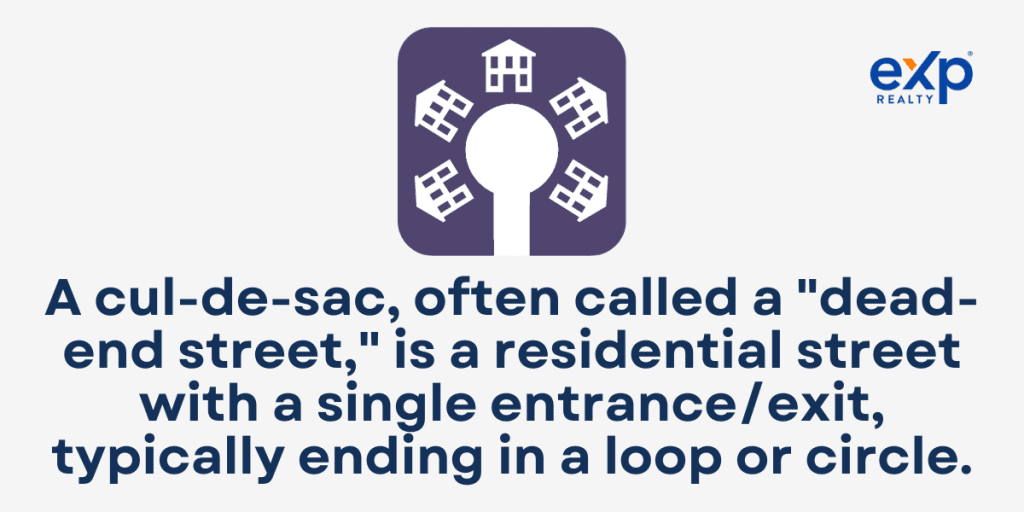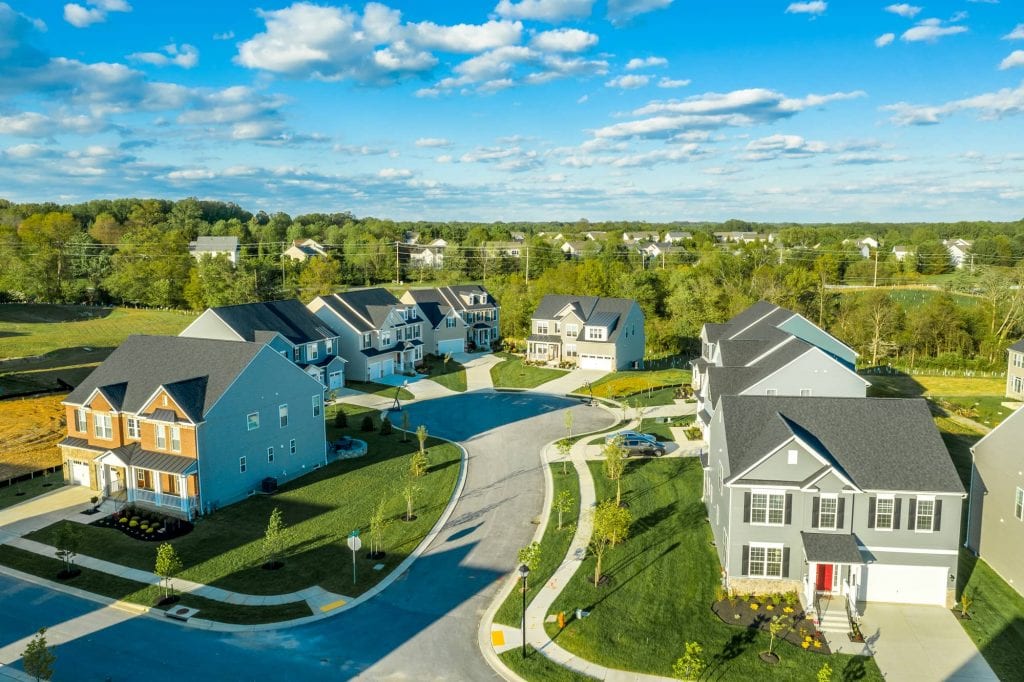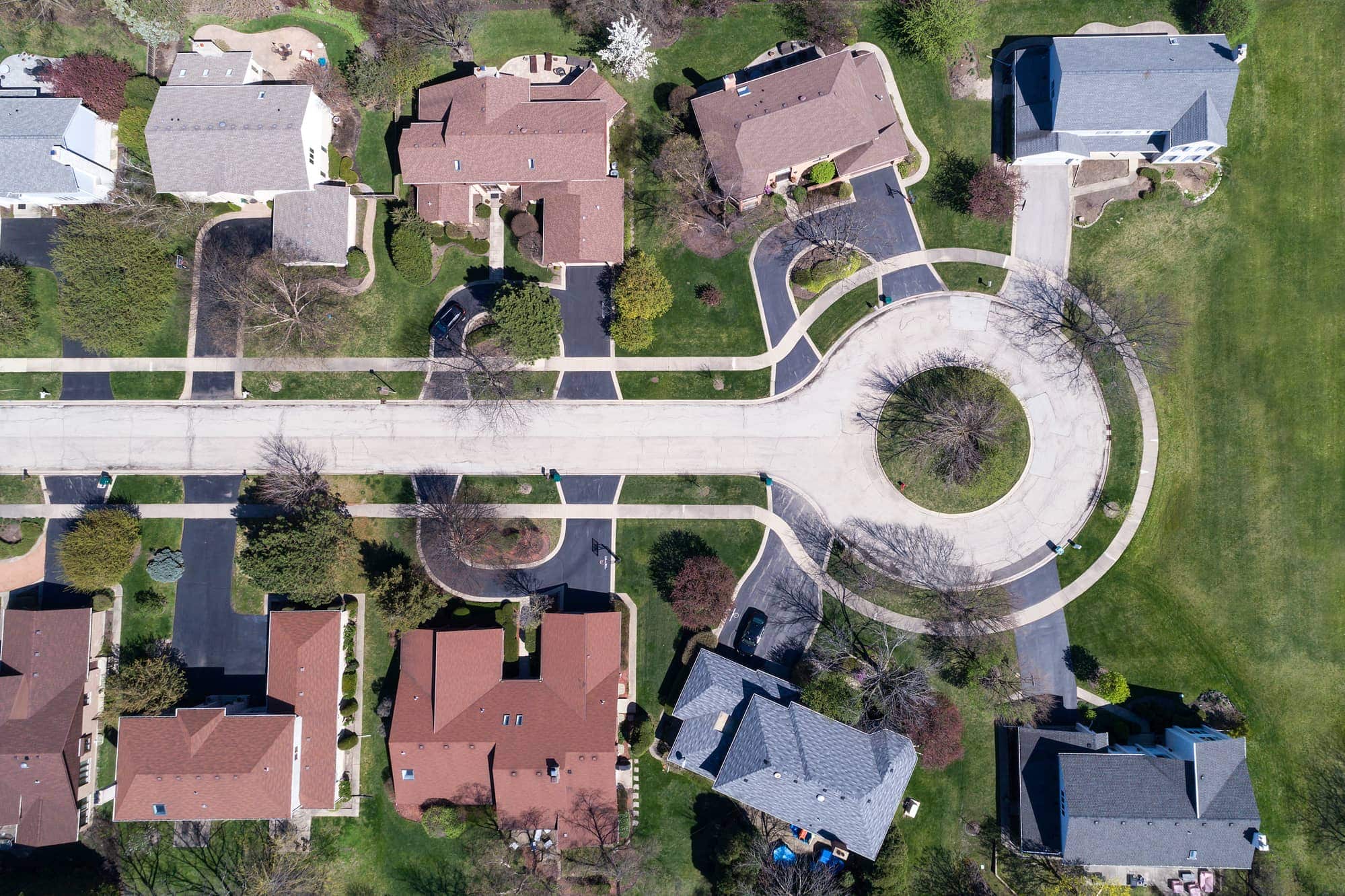Navigating the housing market is always challenging because there are many factors to consider. One design element that’s grown increasingly popular in American cities is the cul-de-sac, or dead-end street.
These cozy, circular streets offer a sense of privacy and seclusion that many homeowners find appealing. But before you sign on the dotted line to buy a new home, this guide will provide information about the ins and outs of living on a cul-de-sac so you can take a closer look at the advantages and disadvantages of this unique type of home ownership.
What Is a Cul-De-Sac?
A cul-de-sac, often called a “dead-end street,” is a residential street with a single entrance/exit, typically ending in a loop or circle. It originated in the 14th century in medieval towns; the design has become a part of 20th-century housing developments.
City records even show plans changing into cul-de-sacs for a more intimate feel in specific neighborhoods. This street type has numerous advantages, but weighing them against potential drawbacks is crucial when considering a purchase.
Pros of Buying a Home in a Cul-De-Sac
The potential of cul-de-sacs and loop streets is undeniable. There’s much to appreciate, from a sense of community to more quiet environments.
Enhanced Safety and Reduced Traffic
One of the most popular features of a cul-de-sac in residences is the obvious reduction in traffic. The unique design naturally keeps away high traffic, especially automobile traffic, ensuring that only those who live there or their visitors are likely to drive through. It leads to a safer environment, with reduced rates of traffic accidents.
As a result, children can play and roam more freely, and pets can be more safely let out. The quiet cul-de-sac offers a peaceful seclusion in a world of bustling city centers and constant movement.
Sense of Community and Neighborhood Camaraderie
Living in a cul-de-sac often creates a tight-knit community. The design of it encourages interaction, leading to more activities with the children and adults and building strong neighborhood bonds. Due to the low traffic and closeness of the homes, it’s easier to remember faces and form real life-long connections.
These relationships become stronger through a community approach to crime prevention, with neighbors looking out for each other, improving the area’s security. It’s similar to the traditional towns of the past, where everyone knew everyone, mixed with the American dream of owning a home.
Tranquility and Privacy
Beyond safety and community, culs-de-sac offer a peaceful environment. The noise is minimized with limited traffic, giving residents comfort that’s hard to find in typical straight streets or central roads.
Because these homes are usually built on plots of land, they tend to be larger than those on ordinary streets, offering bigger backyards and more space between each house. If you want room to entertain or a quiet relaxing spot, cul-de-sac homes provide an ideal setting.
Cons of Buying a Home in a Cul-De-Sac
While the charm of cul-de-sac living is undeniable, there are specific challenges prospective homeowners should be aware of. However, with every potential drawback, there are ways to mitigate, adapt, and make the best of the situation.
Limited Parking Options
With their distinctive design elements, cul-de-sacs can sometimes lead to parking constraints. The restricted space might pose challenges, especially during large gatherings or for households with multiple vehicles.
However, these challenges can be navigated with a bit of forethought. Encouraging carpooling during big events or setting up designated parking zones for guests can help.
Moreover, many cul-de-sac residents agree with neighbors about shared driveway usage, making room for everyone. The sense of community often aids in finding mutual solutions.
Potential Difficulty in Accessing Amenities and Services
With their somewhat secluded nature, cul-de-sac streets mean slightly longer commutes to main roads and commercial areas. And for those who rely on public transport, options might be limited. But it’s all about perspective!
These small inconveniences can be a trade-off for the tranquility and safety of a cul-de-sac. Plus, with the regularity of digital services, groceries or other essentials can be delivered right to your doorstep.
Planning your errands can also reduce frequent trips to the city center.
Higher Costs and Limited Home Variety
Due to the high demand for cul-de-sac properties, prices can sometimes be steeper. Built around the same time, many of these homes’ architectural diversity might be limited, with fewer customization options.
But here’s the silver lining: owning a property in a sought-after location can be a wise long-term investment, appreciating over time.
For those craving a unique touch to their homes, interior renovations and garden landscaping can provide ample opportunities to express individuality and style, making the home truly yours.
Factors To Consider When Deciding To Buy a Home in a Cul-De-Sac
Deciding to purchase a home in a cul-de-sac requires introspection, foresight, and pragmatic reasoning. While offering many advantages, the unique street patterns also come with their own considerations.

Lifestyle and Personal Preferences
The serene ambiance of a cul-de-sac can be the epitome of a tranquil living experience, but it’s essential to gauge if it aligns with your personal preferences. While some thrive in the stillness of a secluded environment, others might crave the hustle and bustle of city centers. Moreover, it’s essential to contemplate future needs.
Could there be potential lifestyle changes on the horizon? In addition to the family, a new job, or even evolving social preferences? It’s worth weighing the allure of a quiet cul-de-sac against these foreseeable changes.
Commute and Access to Amenities
One of the compelling design elements of cul-de-sac streets is their distance from major thoroughfares. While this ensures reduced traffic volumes, it might mean a slightly elongated commute. Evaluating how this impacts daily routines, especially in American cities where drive times can be substantial, is critical.
Additionally, while the seclusion is lovely, how far are you from essential services? Consider the proximity of schools, shopping centers, medical facilities, and recreational areas. Sometimes, the charm of a quiet cul-de-sac will offset the convenience of being closer to urban networks.
Parking and Space Requirements
Parking can be a significant consideration, especially in households with multiple vehicles. Assess your parking needs, especially if you foresee a vehicle increase in the coming years.
Guest parking, especially during social gatherings, can also be a determining factor. And remember storage! While often boasting larger lots, cul-de-sac homes might have limited storage options, especially if no garage or shed exists.
Resale Value and Investment Potential
Real estate is as much an emotional decision as a financial one. Considering the resale value of a cul-de-sac property is crucial. Such properties often see appreciable growth in value due to their demand.
However, market trends, the overall health of the economy, and local factors like upcoming infrastructure projects can play a role. Consulting with an expert real estate agent can provide insights into the potential return on investment.
Key Takeaways
Buying a home in a cul-de-sac presents a unique set of advantages and challenges deeply rooted in its distinct design elements and neighborhood dynamics.
Every prospective homeowner should weigh these factors against their lifestyle preferences, current and future needs, and financial considerations. While a cul-de-sac might be the epitome of suburban dreams for some, it might not align with the aspirations of others. It’s all about personal evaluation.
Like any home-buying decision, living in a cul-de-sac blends heart and mind. To ensure you’re making the right choice, delve deeper, understand your priorities, and always consult an expert to guide you through the intricate world of real estate. Are you looking to explore more properties or need expert guidance?
Search for properties on eXp Realty or contact a local eXp Realty agent who can tailor their advice to your unique circumstances for your future home on a cul-de-sac.
FAQs: Cul-De-Sac
As urban areas grow, many homebuyers think about residential streets and their potential impact on their family’s lifestyle. Let’s address some common questions about the cul-de-sac.
Is cul-de-sac good or bad?
A cul-de-sac has both pros and cons. Pros include increased safer traffic environments, a sense of community, and peacefulness. Cons may involve limited parking options, potentially longer commutes, and higher housing costs. The “good” or “bad” is subjective and depends on what you are looking for.
What is the difference between a circle and a cul-de-sac?
A circle is a roundabout or a circular road pattern used to manage traffic flow. A cul-de-sac is a dead-end street with a single entry/exit point, usually forming a loop or circle at its end. It is primarily used in residential areas for limited traffic.
What are the differences between a cul-de-sac development and a traditional grid development in suburbs?
Cul-de-sac developments prioritize safety and tranquility by minimizing traffic. Grid developments, typical of 19th-century gridiron patterns, provide direct connections between streets, enhancing accessibility and city center connectivity but can have higher traffic volumes.
Would a house on a main road have better Feng Shui than one in a cul-de-sac?
Feng Shui principles often favor houses with free-flowing energy. While main roads signify active energy, they also denote fast, aggressive energy. Cul-de-sacs, conversely, may risk stagnant energy due to their closed nature. However, Feng Shui is complex; specific house placements and design elements also play crucial roles.
What is a cul-de-sac?
A cul-de-sac is a dead-end street with only one entrance/exit, often forming a loop or circular shape at its end. This street pattern is primarily designed for residential areas, providing lowest traffic, enhancing safety, and fostering a community atmosphere.





